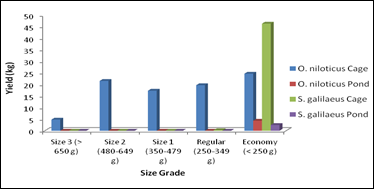International Journal of Fisheries and Aquatic Studies
Volume 1, Issue 5, 2014
Comparative growth study of Oreochromis niloticus and Sarotherodon galilaeus under two different culture regimes (Hapa-In-Pond and cage systems).
Author(s): Emmanuel Tetteh-Doku Mensah, Felix Klenam Yao Attipoe, Ken Atsakpo
Abstract: Nile tilapia and the mango tilapia are two most dominant cultured tilapia species in Ghana and have contributed significantly to the aquaculture development of the country. A 24 week trial was conducted to study the growth of these two species under two different culture regimes (cages and hapa-in-pond). Mixed sex fingerlings of average weight 26.90 ± 0.21 g were stocked in cages and hapa-in-pond at a rate of 32 fish/m³ and 5 fish/m² respectively. Fingerlings were fed a 36% crude protein commercial fish diet. A comparison of growth performance of fish under the two culture regimes in terms of weight gain was in the following order; O. niloticus (in cage) > S. galilaeus (in cage) > O. niloticus (in hapa) > S. galilaeus (in hapa). There were significant differences in final mean weights, mean daily weight gain, specific growth rate and mean relative weight gain between the culture regimes except for the culture between S. galilaeus (in cage) and O. niloticus (in hapa). Although the net yield was high in O. niloticus under the 2 culture regimes, survival was relatively high among S. galilaeus under the same culture systems. A high value of fish crop was realized in O. niloticus under the two culture regimes, however, profit index did not vary significantly from each other. In the sexes, O. niloticus showed a distinct variation in male to female population in which the males were found to grow twice more than the female population, however, population of S. galilaeus in all culture regimes showed an almost equal growth. In general, although O. niloticus shows distinct variation in sizes among its sexes other than S. galilaeus, it showed superior growth with an appreciable feed conversion rate, hence its sex reversal is highly encouraged for its culture to be more profitable..

Fig: A bar chart showing size grades of yield of fish in the two culture regimes.
Download Full Article: Click Here
Journal is Indexed and Abstracted in following Database(s).
    |
    |
       |

